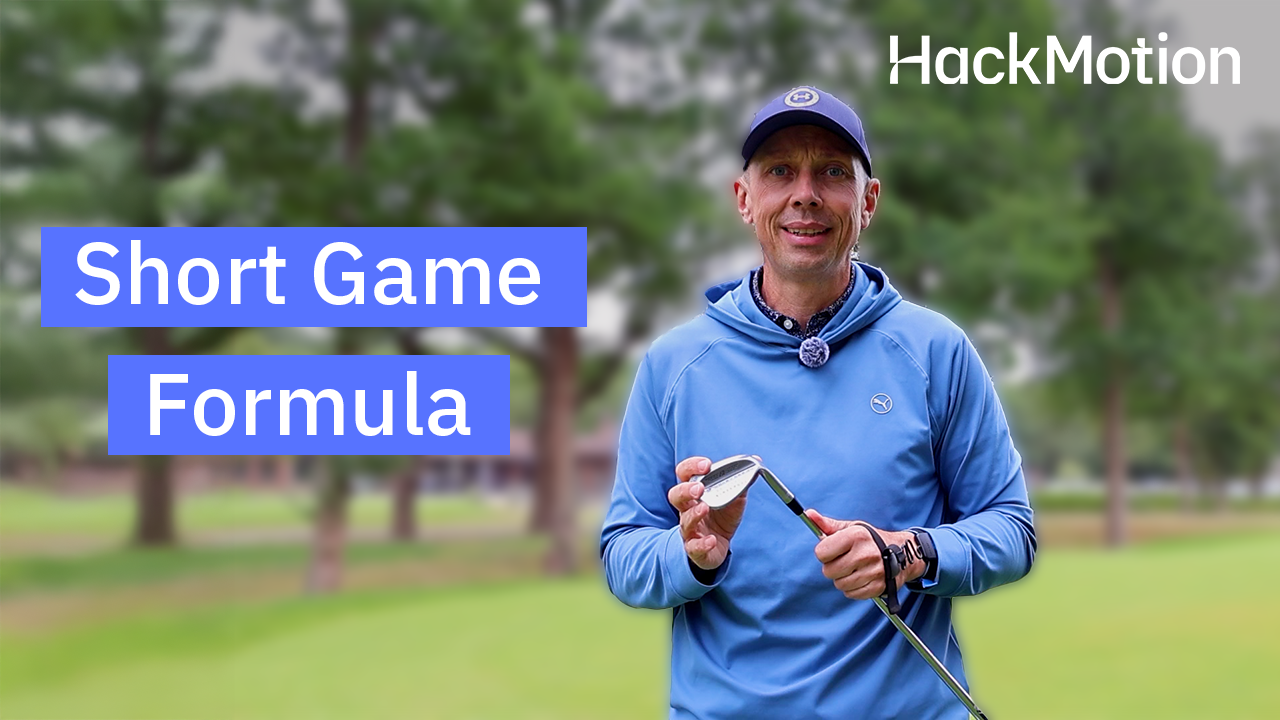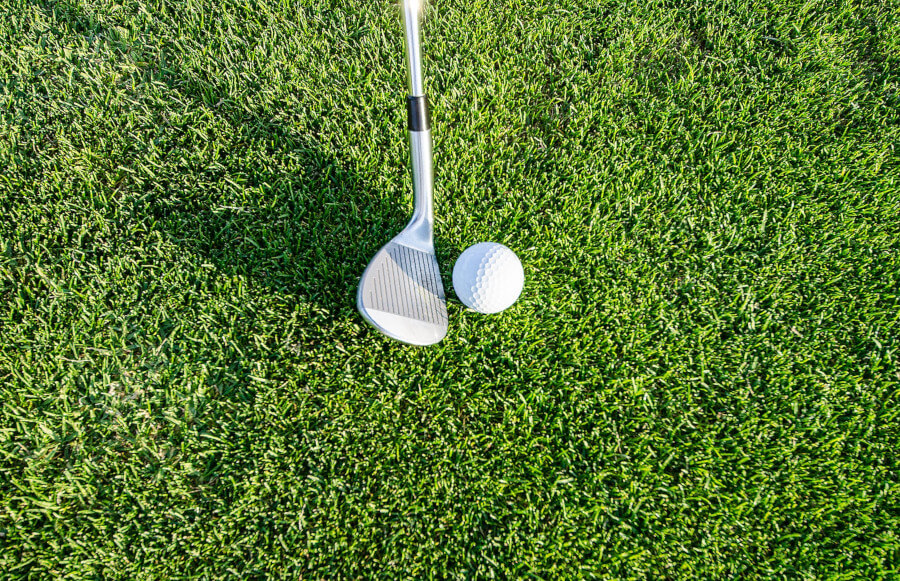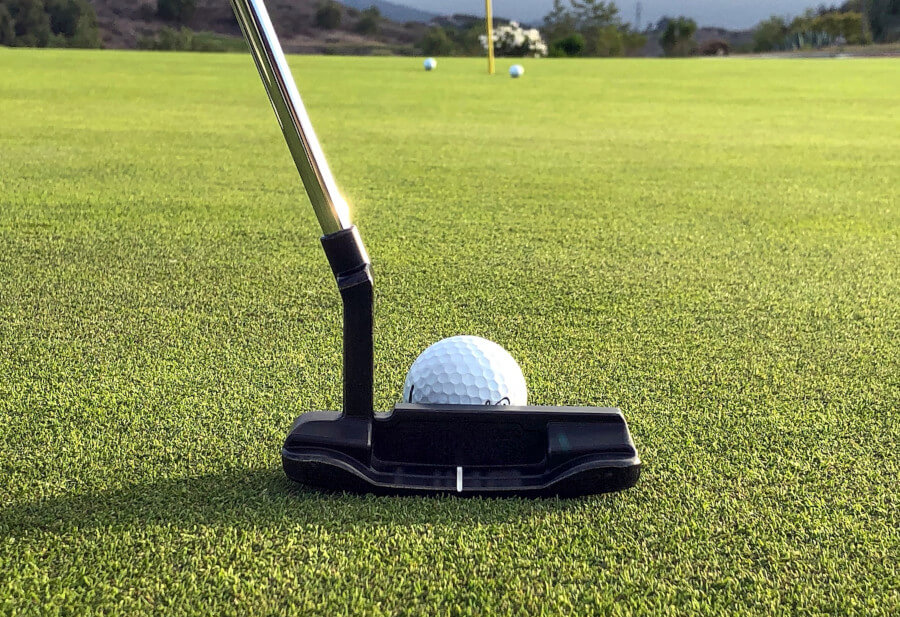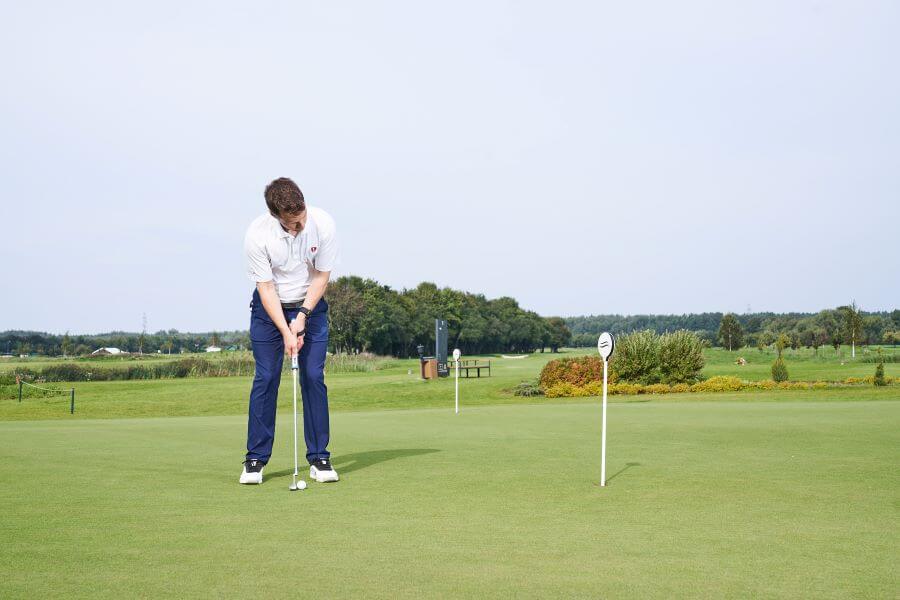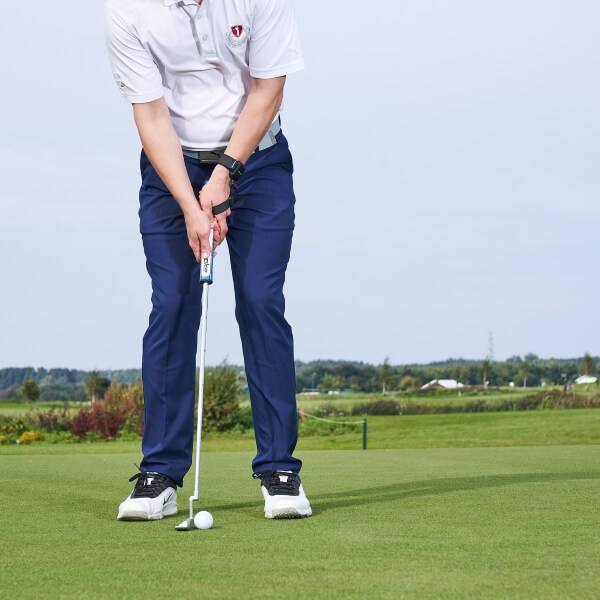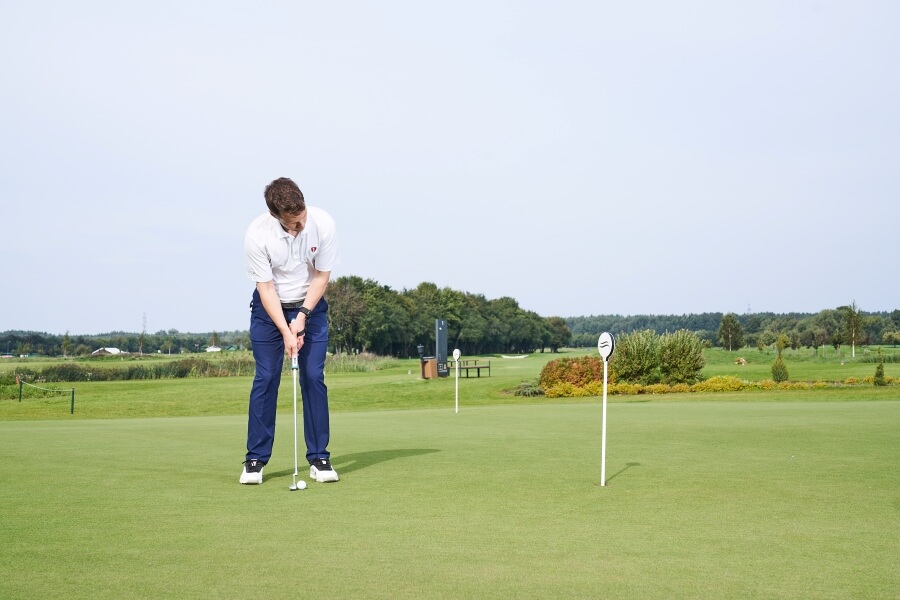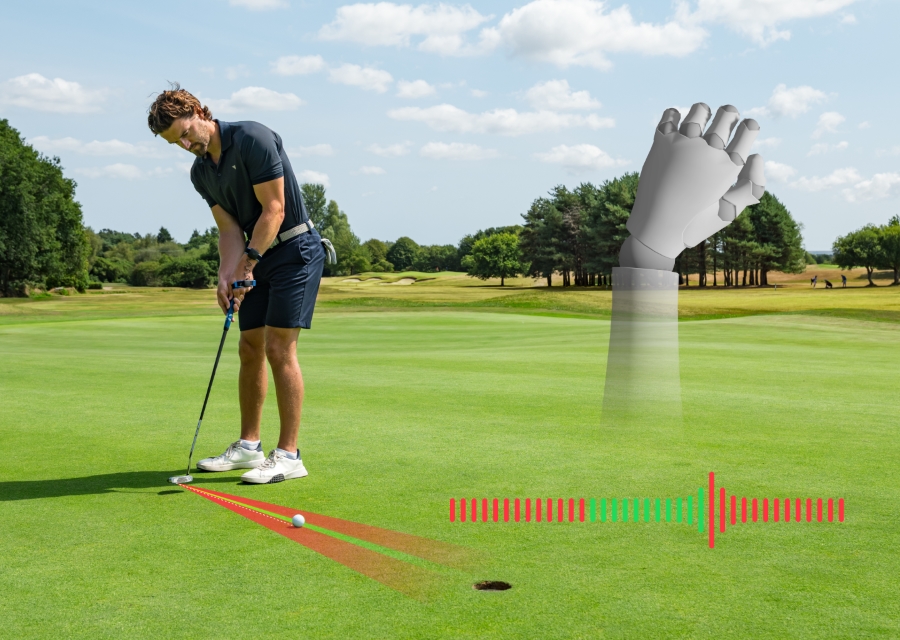15 Best Golf Chipping Tips to Consistently Get Up and Down
A consistent chipping game is vital to your success on the golf course.
Amateurs are often left scrambling to get up and down from the side of the green, and a weak short game leads to dropped shots.
In this post, I reveal my 15 best golf chipping tips to add consistency to your wedge game.
By the end of this post, you’ll know how to produce forward shaft lean, create wrist flexion on the backswing, and induce softer hands. In addition, I’ll give you some of the professional golfer data we collected at HackMotion to see how it’s really done!
Tips for Better Chipping in Golf (Key Takeaways)
If you don’t have time to read through our chipping tips right now, here are the key things you must remember.
- You need more than one chip shot. Learn low, mid, and high trajectories to handle any lie or landing zone.
- Ball position, stance width, and grip pressure all impact your consistency. Subtle tweaks can fix thin or chunked shots.
- Soft hands and a narrow stance improve feel and control. Avoid setting up like you’re hitting a full swing.
- Opening the clubface (correctly) helps the wedge glide through the turf and adds forgiveness, just don’t overdo it.
- Keep your wrists stable and avoid flipping. HackMotion helps you train proper wrist extension for clean impact.
- Use distance control drills to sharpen feel. The best chippers pair technique with touch.
Contents
- The 15 Tips for Better Chipping in Golf
- 1. Sternum Ahead of the Ball
- 2. Ball Position
- 3. Feet Closer Together
- 4. Soft Hands
- 5. Open the Clubface
- 6. Wrist Flexion on the Backswing
- 7. Add a Little Extension Through Impact
- 8. Use Body Rotation to Fix Contact Problems
- 9. Straight Back, Straight Forward
- 10. Pick a Target 1/3 of the Way to the Target
- 11. Distance Control Training
- 12. Master the Rough and Tight Lies (Be Versatile)
- 13. Brush the Turf
- 14. Build Your Short Game Toolbox: Learn All Three Chipping Trajectories
- 15. Practice Like You Play
- Final Thoughts
The 15 Tips for Better Chipping in Golf
1. Sternum Ahead of the Ball
Set up with your sternum (or shirt buttons) slightly ahead of the ball and about 55% of your weight on your front foot.
This position helps you take the club up and down more naturally for a clean strike. It also encourages level shoulders and better rotation through the shot. One common mistake is leaning the shaft forward without actually shifting weight.
Make sure your weight is truly on your lead side. Test this setup around the green to find the right balance for your game.
2. Ball Position
A lot of golfers think chipping means playing the ball off the back foot, but that’s a mistake. When the ball is too far back, it’s harder to square the face and rotate properly through the shot.
Instead, position the ball just behind center, between the middle of your stance and your back foot.
Keep your stance narrow and avoid pushing the ball too far back. This slight adjustment helps you strike the ball at the low point of your swing, generating better friction, spin, and control.
3. Feet Closer Together
How can your brain recognize it’s time for a short shot if your setup looks like a full swing?
If your feet are too far apart, your body tends to lock up, and your upper body takes over, which is not ideal for chipping.
A narrower stance encourages better feel, balance, and control. Some great chippers even stand with their feet nearly touching.
You don’t need to go that extreme, but try setting up with your feet much closer than shoulder width. You’ll likely feel more connected and in control right away.
4. Soft Hands
Learning to chip with soft hands can transform your short game. Softer grip pressure improves feel, feedback, and distance control, all without sacrificing control of the club.
A light grip helps you create a smooth, pendulum-like motion and encourages your body to stay involved in the swing.
You’re still in control, but you’re letting momentum and rotation do the work. Try it, and you’ll likely notice a big difference in consistency and touch around the green.
5. Open the Clubface
Many golfers chip with a square clubface, but that can lead to digging or inconsistent contact.
Opening the face slightly at address exposes the bounce, helping the club glide through the turf for cleaner, more forgiving strikes.
To do it right, open the face a few degrees before you grip the club and keep it there. This lets you lean the shaft forward without turning your wedge into a low-lofted blade.
Just don’t overdo it. If the face is too open, the leading edge lifts too much, and you risk skulling or sliding under the ball. A slight open angle gives you control, consistency, and better turf interaction.
6. Wrist Flexion on the Backswing
Wrist action has to happen in the chip shot.
Golfers love to tell each other to keep their wrists quiet, but that advice misses an important detail: the best players do move their wrists; they just know how to control them.
When chipping, especially on standard shots or bump-and-runs, a small amount of lead wrist flexion in the backswing helps position the club on plane and promotes cleaner contact.
This slight bowing of the lead wrist keeps your hands ahead of the clubhead and helps you bottom out your swing at the right point just after the ball.
If you’re looking for a more compact, repeatable chipping motion, especially for those tricky 10- to 30-yard shots, working on flexion at the top is a smart place to start.
Wrist Identity Drill
This drill helps you train lead wrist flexion on the backswing and eliminate flipping at impact.
Wrist Identity Drill – Step by Step:
- Set up for a basic chip shot, ball slightly back of center, weight forward.
- As you begin the takeaway, feel your lead wrist bow slightly (flexion).
- Keep your wrist in that flexed position as you complete a short backswing.
- Rotate your chest and hips through the shot, no flipping!
- Optional: use HackMotion to see how much flexion you’re producing and whether it holds through the swing.
7. Add a Little Extension Through Impact
While we are on the topic of wrists, we should touch on the concept of extension through impact. On most golf shots, you want to eliminate the extension you have through impact.
However, with a chip, feeling that slight bit of flexion in the backswing that rotates to extension on the downswing is quite helpful.
8. Use Body Rotation to Fix Contact Problems
Lack of rotation causes breakdown in arm structure and poor radius control, leading to fat and thin shots. Instead of focusing only on tilt and setup, you should work on making sure that your body (not just arms and wrists) rotates to stabilize the entire chipping motion.
The Club-in-the-belly turn drill is the perfect way to do this.
Club-in-the-Belly Turn Drill – Step by Step:
- Grip down on a wedge and press the butt end into your belly.
- Make short chip swings while keeping the club touching your stomach.
- Focus on rotating your body back and through, rather than swinging with just your arms.
- Feel how your arms and torso stay connected. This helps maintain the proper radius.
9. Straight Back, Straight Forward
The straight-back, straight-through motion works well for short chip shots, especially when you’re trying to mimic a putting stroke and let the ball gently run up to the hole.
Focus on creating a simple pendulum motion with a short backswing and matching follow-through.
Be sure to rotate your hips and shoulders to maintain proper posture. If you don’t, you risk chunking the shot or catching it thin.
This method won’t give you much power, so it’s smart to use a less lofted club like a pitching wedge, 8-iron, or even a 7-iron for bump-and-run shots. As you move into longer chips, you can shift to a more upright swing path with added wrist hinge.
10. Pick a Target 1/3 of the Way to the Target
Besides trying to strike the ball cleanly, you have the issue of green reading to understand, as the slope and green speed impact your shot.
Look at the green between your ball and the hole, and identify how it breaks and its pace. Next, identify the best line to the cup, and follow it back from the target to your ball.
The further away your target is, the harder it becomes to hit the spot. Breaking the lineup into stages and hitting checkpoints is easier to achieve.
11. Distance Control Training
Most amateur golfers lose strokes around the green because they don’t control how far the ball rolls out, not because they mis-hit it. Even if your contact is solid, bad distance control can leave you 10 feet short or 10 feet long.
The problem worsens when players lack proper distance control practice. Try working on a distance control ladder.
Distance Control Ladder Drill – Step by Step:
- Place 3–4 towels or headcovers on the ground, spaced out like ladder rungs (start at 3, 6, and 9 paces).
- Use your stock chipping setup and your go-to wedge (gap or sand wedge).
- Try to land one ball on each “rung” using the same tempo, but adjusting only your backswing length.
- Focus on how far each swing feels and where it lands.
- Repeat the ladder, up and back down, until you can land 3 balls in a row on each target.
12. Master the Rough and Tight Lies (Be Versatile)
The lie you’re facing should change your setup. Ball position, club choice, and how much wrist hinge you use all depend on the grass and how the ball is sitting.
Getting this wrong results in chunky or thin shots. But once you learn to adjust, especially with your wrists and ball position, it becomes much easier to control launch and spin, even from tricky spots.
Here’s a quick guide to help:
| Lie Type | Club | Ball Position | Wrist Action | Face Setup |
|---|---|---|---|---|
| Tight lie | Pitching wedge | Back | Quiet wrists | Square, toe down |
| Fluffy rough | Lob wedge | Slightly back | More hinge, full release | Open |
| Firm / bare | 9-iron | Back | Short hinge, firm release | Slightly closed |
| Sitting up | Sand wedge | Middle | Normal hinge | Square |
| Buried rough | Lob wedge | Back | Steep hinge, hit down | Wide open |
13. Brush the Turf
Great chip shots come from brushing the grass, not digging into it. The goal is to make clean contact with minimal turf interaction, which boosts spin, helps the ball check up, and gives you more control around the green.
Brushing the turf is easier when your wrists don’t collapse and the shaft stays on plane. This video helps explain how to maintain wrist extension using simple visual feedback.
Tee in the Grip Drill – Step by Step:
- Stick a tee in the butt end of the grip.
- In your backswing, make sure the tee points down the target line, not off to the side.
- Keep some lead wrist extension (a “cupped” feel) in the takeaway to avoid getting too shallow or flipping.
- Use HackMotion to measure extension consistency.
14. Build Your Short Game Toolbox: Learn All Three Chipping Trajectories
To get up and down more often, you need more than one chip shot.
Here are the three key trajectories every golfer should have — each with its own wrist motion:
- Low Shot (Bump and Run) – Stand closer, shaft upright, feel thumbs pointing down (ulnar deviation). Great for firm lies and lots of green. Use a 9-iron or PW.
- Mid Trajectory (Stock Chip) – Normal stance, slight wrist hinge, and small lead wrist flexion. This is your go-to chip with a sand or gap wedge.
- High Shot (Lob/Flop) – Open face, wide stance, feel cupping (lead wrist extension) throughout. Best for soft landings or tough lies. Use your lob wedge.
15. Practice Like You Play
One of the biggest mistakes in short game practice is simply hitting ball after ball without a plan. To actually improve, simulate real conditions.
Change clubs, lies, and landing spots. Set goals for up-and-down percentage or how close you leave the ball to the hole.
Use HackMotion to track your wrist angles during practice. If you’re flipping, casting, or struggling with consistent contact, the data will help you pinpoint where it’s going wrong and show you when it’s getting better.
Final Thoughts
Our 15 best golf chipping tips are designed to optimize your setup, backswing, downswing, and follow-through.
Always keep more weight on the front leg and employ forward shaft lean to maximize compression, friction, and spin.
Finally, remember to produce wrist flexion at the top of your backswing to position the club to attack the ball and strike it at the swing’s low point. To improve your wrist angles for better chipping in golf, consider the guidance of the HackMotion Sensor.
